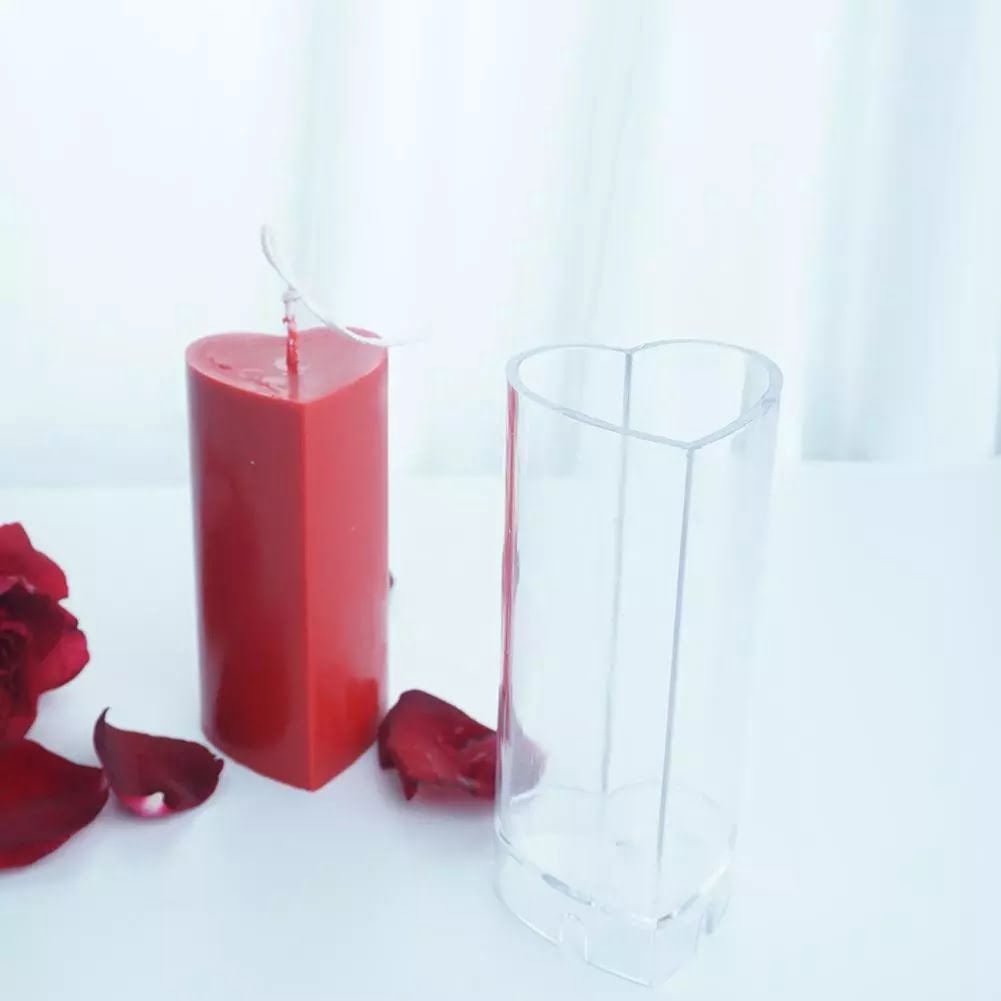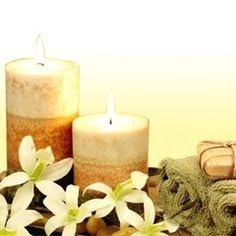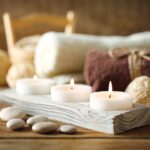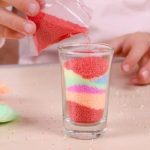Candle-making is an age-old craft that has experienced a resurgence in popularity in recent years. People are not only drawn to the soothing glow and gentle flicker of candles but also to the therapeutic benefits they offer. Adding herbs to candles is a practice that has gained considerable attention in the crafting community, allowing for an even more personalized and meaningful experience.
Herbs have long been used for their aromatic properties and healing qualities, making them a natural choice for enhancing the ambiance and overall effectiveness of candles. By infusing herbs into the wax, you can create unique scents that not only fill your space with delightful aromas but also provide various therapeutic effects.
The act of adding herbs to candles not only adds depth and complexity to their fragrance but also contributes to their aesthetic appeal. Whether you prefer rustic botanicals or vibrant dried flowers, there are endless possibilities for incorporating herbs into your candle designs. From subtle hints of lavender or rosemary to bolder combinations like sage and thyme, the choice of herbs allows you to truly personalize your creations.
By learning how to add herbs to candles when making them, you can unleash your creativity while enjoying the numerous benefits they bring. In this article, we will explore several aspects of this growing trend, including selecting the right herbs, using essential oils alongside herbs, step-by-step instructions on mixing them with wax, delicious herbal candle recipes, finishing touches for a truly personal touch, as well as safety precautions and measures.
So let’s dive into the world of herbal candle-making and discover all it has to offer.
The Benefits of Adding Herbs to Candles
When it comes to candle-making, incorporating herbs into your creations can offer a wide range of benefits. Not only do they enhance the aroma of the candles, but they can also provide therapeutic effects and add a visually appealing element to your finished products.
One of the main benefits of adding herbs to candles is the aroma enhancement they bring. Different herbs have distinct scents that can help create a truly unique candle experience. For example, lavender can promote relaxation and stress relief, while citrus herbs like lemon and orange can uplift and energize. By carefully selecting herbs with complementary scents, you can create a multi-layered fragrance that will fill your space with an enticing aroma.
In addition to aromatic benefits, certain herbs are known for their therapeutic effects. For example, eucalyptus has been used for centuries for its respiratory benefits and ability to clear congestion. Rosemary is believed to improve focus and mental clarity. By incorporating these herbs into your candles, you can enjoy their therapeutic properties through aromatherapy.
Lastly, adding herbs to your candles can greatly enhance their aesthetic appeal. Sprinkling dried lavender petals or rosemary leaves on top of poured candles not only adds visual interest but also creates an elegant and natural look suitable for any decor style. You can also experiment with layering different-colored herbs in your container before pouring the wax for a stunning layered effect.
| Advantages | Examples |
|---|---|
| Aroma Enhancement | Lavender – relaxation; Lemon – energy boost |
| Therapeutic Effects | Eucalyptus – respiratory benefits; Rosemary – mental clarity |
| Aesthetic Appeal | Dried lavender petals, rosemary leaves |
Selecting the Right Herbs
When adding herbs to candles, it is essential to select the right herbs based on the desired scent, color, and intention. The choice of herbs will greatly impact the overall aroma, visual appeal, and therapeutic effect of the candles. Here are some tips for selecting the appropriate herbs:
Choosing for Scent
When selecting herbs for their scent, it is important to consider personal preferences and the desired ambiance. For a soothing and calming atmosphere, lavender or chamomile can be great options. If you prefer a refreshing scent, consider using peppermint or eucalyptus. For a warm and cozy ambiance, try using cinnamon or vanilla. Experiment with different combinations to create unique and pleasing scents.
Considering Color
In addition to scent, herbs can also add visual interest to your candles. Some herbs impart vibrant colors when infused in wax. For example, rose petals can create a delicate pink hue while dried marigold flowers can add a beautiful orange tint. Consider the color scheme you have in mind for your candles and choose herbs accordingly.
Intention and Therapeutic Effects
Many herbs have known therapeutic properties that can enhance the overall benefits of using herbal candles. For instance, if you’re looking to promote relaxation and stress relief, consider incorporating chamomile or lavender into your candle-making process. If you want to create an uplifting atmosphere or boost energy levels, citrus-scented herbs like lemon balm or lemongrass are excellent choices. Research different herbs and their associated properties to align them with your intentions.
It’s important to note that not all herbs are suitable for use in candles due to different burning properties and potential safety concerns (such as allergies or skin irritations). Therefore, it is advisable to research each herb thoroughly before deciding which ones to use in your candle-making process.
Dried vs. Fresh Herbs
When adding herbs to candles, one important decision to make is whether to use dried herbs or fresh herbs. Both options have their pros and cons, which should be taken into consideration in order to achieve the desired scent potency and visual appeal.
Using dried herbs in candle-making offers several advantages. Firstly, dried herbs tend to have a more intense scent compared to their fresh counterparts. This is because the drying process concentrates the natural oils and fragrances present in the herb, resulting in a stronger aroma when burned.
Additionally, dried herbs are generally more readily available and easier to store for long periods of time. They also tend to be less susceptible to mold or rotting, making them a practical choice for candle-making projects.
On the other hand, using fresh herbs can provide unique benefits as well. Fresh herbs often have a more vibrant color and can add a visually appealing element to your candles. The presence of fresh leaves or petals can create an eye-catching contrast against the wax, enhancing the overall aesthetic appeal of the finished product.
Furthermore, some believe that fresh herbs may retain more of their inherent therapeutic properties compared to dried ones. For those seeking a more natural and holistic approach, incorporating freshly picked herbs into candles may be preferred.
To decide between dried or fresh herbs for candle-making, consider your specific goals and preferences for the final product. If you are looking for a strong fragrance and convenience, dried herbs may be the way to go. However, if visual impact and potential therapeutic benefits are your priorities, fresh herbs might be worth exploring.
Mixing Herbs with Wax
One of the key steps in incorporating herbs into candle-making is mixing them with wax. This process ensures that the herbs are evenly distributed throughout the candle, allowing for maximum scent release and aesthetic appeal. Here is a step-by-step guide on how to infuse herbs into the wax:
- Prepare your materials: Gather your chosen herbs, dried or fresh, and ensure they are clean and free from any dirt or debris. You will also need soy or beeswax, a double boiler or melting pot, a thermometer, and candle molds or containers.
- Select your wax: Choose between soy or beeswax for your candles. Soy wax has a lower melting point and enables better herb infusion, while beeswax provides a natural honey-like scent and burns longer. It’s important to consider the characteristics of each wax before making your decision.
- Melt the wax: Use a double boiler or a melting pot to melt the wax over medium heat. Stir occasionally to ensure even melting and avoid scorching.
- Prepare the herbs: While the wax is melting, finely chop or crush your herbs to increase their surface area for better infusion. You can also use a mortar and pestle to gently grind them if needed.
- Infuse the herbs: Once the wax reaches its desired temperature (usually around 180-185°F for soy wax and 145-150°F for beeswax), carefully add in your prepared herbs. Stir continuously for about 10 minutes to thoroughly incorporate them into the wax.
- Strain if necessary: If you prefer a smoother appearance without visible herb particles in your candles, strain the infused wax through cheesecloth or muslin cloth after stirring. This will remove any excess herb residue.
- Pour into molds or containers: Once the wax is infused with the herbs, remove it from heat and allow it to cool slightly. Pour the melted wax into your chosen candle molds or containers, leaving some space at the top for any final decorative touches.
By following these step-by-step instructions, you can successfully infuse herbs into your candle-making process, ensuring that the herbs are evenly distributed throughout the wax. This will enhance both the scent and visual appeal of your candles, allowing you to fully enjoy their aromatic and aesthetic benefits.
Using Essential Oils with Herbs
When it comes to making herbal candles, one way to amplify their fragrance and customize their scent is by incorporating essential oils along with the herbs. Essential oils are highly concentrated plant extracts that not only add a burst of aroma but also provide additional therapeutic benefits. By combining these oils with selected herbs, you can create a truly unique and personalized fragrance experience.
Understanding Essential Oils
Essential oils are derived from various parts of plants, such as flowers, leaves, stems, and even roots. These oils carry the distinctive scent and properties of the plant they are extracted from. For example, lavender essential oil has a calming effect, while citrus oils like lemon or orange can uplift and energize the senses. Before incorporating essential oils into your herbal candles, it’s important to research their individual characteristics to select those that complement your chosen herbs.
Creating Blends
One of the advantages of using essential oils in conjunction with herbs is the ability to create custom blends. Whether you’re looking for a relaxing ambiance or a vibrant burst of fragrance in your candle, experimenting with different combinations can help you achieve your desired outcome. For example, pairing rosemary herb with eucalyptus oil can create an invigorating and refreshing scent perfect for boosting focus and concentration during work or study hours.
Proper Usage
It’s crucial to remember that essential oils are highly concentrated substances and should be used sparingly. When mixing them with herbs for candle-making purposes, start with small amounts until you achieve your desired aroma intensity. Additionally, consider the specific safety guidelines provided by each essential oil manufacturer as some may have restrictions on direct contact with skin or oral consumption.
By incorporating essential oils into your herb-infused candles, you not only enhance their overall fragrance but also tap into the therapeutic properties of these powerful plant extracts. The combination of herbs and essential oils offers a delightful and personalized experience that can uplift, soothe, or invigorate your senses depending on your desired mood or intention.
Experimenting with different blends will allow you to create unique scents that bring joy and relaxation to both yourself and those who enjoy your handmade candles.
Herbal Candle Recipes
Creating your own herbal candles is a wonderful way to harness the power of herbs while indulging in a relaxing and aromatic experience. By combining various herbs, you can customize your candles to promote specific intentions and enhance their therapeutic effects. Here are some delightful DIY herbal candle recipes that you can try at home:
1. Calming Lavender Blend:
- Herbs: Lavender, Chamomile
– Benefits: Promotes relaxation, reduces stress and anxiety 2. Invigorating Citrus Mix:
- Herbs: Lemon Verbena, Lemongrass, Orange Peel
– Benefits: Boosts energy and focus, uplifts mood 3. Grounding Patchouli Combination:
- Herbs: Patchouli, Sandalwood
– Benefits: Enhances grounding and stability, aids meditation 4. Refreshing Peppermint Fusion:
- Herbs: Peppermint Leaves
– Benefits: Stimulates mental clarity and concentration, relieves headaches To make these herbal candles, follow these simple steps:
- Step 1: Gather the necessary materials – soy or beeswax, candle wick(s), heat-safe containers or molds, double boiler (or a makeshift one using a heat-proof bowl over a pot of boiling water), thermometer.
- Step 2: Prepare your herbs by either drying or chopping them into small pieces. Remember to remove any excess moisture if using fresh herbs.
- Step 3: Melt the wax in the double boiler until it reaches the recommended temperature according to the wax manufacturer’s instructions.
- Step 4: Once melted, remove from heat and let it cool slightly before adding your selected herbs. Stir gently to ensure even distribution.
- Step 5: Carefully pour the infused wax into your desired containers or molds. Insert the wicks into the center of each candle and secure them in place.
- Step 6: Allow the candles to cool and solidify completely before trimming the wicks to the desired length.
These herbal candle recipes are just a starting point, and you can get creative by experimenting with different combinations of herbs to suit your preferences and intentions. Enjoy the process of crafting your own unique herbal candles and bask in their soothing glow while reaping the benefits of aromatherapy.
Finishing Touches
Decorating and personalizing herbal candles is an exciting and creative part of the candle-making process. Adding finishing touches not only enhances the aesthetic appeal of the candles but also allows for a unique and personalized touch. In this section, we will explore different ways to creatively decorate and personalize your herbal candles with herbs, dried flowers, and ribbons.
One simple yet effective way to decorate your herbal candles is by incorporating herbs directly onto the surface of the candle. After pouring the melted wax into the container or mold, sprinkle a small amount of dried herbs over the top. This will create a beautiful botanical look and add texture to the finished candle. Some popular herbs used for decoration include lavender buds, rose petals, chamomile flowers, or even small sprigs of fresh herbs like thyme or rosemary.
Another way to personalize your herbal candles is by attaching dried flowers or herbs to the outside of the container. You can do this by gently pressing dried flowers or herb sprigs onto the sides of the container before the wax has fully cooled and hardened. These natural additions can create a stunning visual effect when combined with transparent jar containers.
Ribbons are another fantastic option for adding a decorative touch. Choose ribbons that complement the colors and scents of your chosen herbs and tie them around the neck of the container or as a band around pillar candles. Ribbons not only add elegance and charm to your herbal candles but can also make them perfect gifts for loved ones.
Remember to be mindful when using decorative elements such as dried flowers or ribbons near flames. Ensure that they are kept away from open flames while lit, or use flame-resistant materials if you plan on burning them regularly.
Adding finishing touches to your herbal candles not only elevates their appearance but also allows you to express your creativity and add a personal touch to each one. Whether it’s through sprinkling dried herbs on top, attaching dried flowers to the outside, or tying ribbons around the containers, these decorative elements will make your herbal candles truly unique and visually appealing.
Precautions and Safety Measures
When incorporating herbs into candle-making, it is important to be aware of safety precautions to ensure a safe and enjoyable crafting experience. One of the key concerns when using herbs in candles is maintaining proper herb-to-wax ratios. Adding too many herbs to the wax can lead to uneven burning and potentially dangerous situations, such as excessive smoke or even flare-ups.
To maintain a safe herb-to-wax ratio, it is generally recommended to use no more than 10% herbs by weight in your candle recipe. This means if you are using 100 grams of wax, you should use no more than 10 grams of herbs.
It’s also important to consider the size and container of your candle when determining the appropriate amount of herbs to use. Larger candles may need more herbs for an effective scent throw, while smaller containers require less.
In addition to herb-to-wax ratios, fire hazards should also be taken into consideration. Some dried herbs are highly flammable and can pose a risk if not used properly in candles. It is essential to choose dried herbs that have low flammability properties and avoid highly combustible materials like dried flowers or grasses.
To further minimize fire hazards, it is advisable to keep candles with herbs away from flammable objects, never leave them unattended while lit, and trim the wick regularly for proper burning. Following these safety measures will help ensure that your herbal candles are not only beautiful but also safe to enjoy.
By being mindful of proper herb-to-wax ratios and fire hazards associated with using dried herbs in candles, crafters can confidently experiment with creating beautiful herbal candles without compromising safety. Embracing these precautions will allow candle makers to fully enjoy the benefits and therapeutic qualities that herbal additions bring to their creations without any unnecessary risks.
Conclusion
In conclusion, incorporating herbs into candle-making is a growing trend that offers numerous benefits and enhances the overall crafting experience. By adding herbs to candles, individuals can enjoy the aroma enhancement, therapeutic effects, and aesthetic appeal that these natural ingredients bring. The selection of the right herbs is crucial in achieving the desired scent, color, and intention for the candles.
Whether using dried or fresh herbs, each option has its pros and cons. Dried herbs tend to have a more potent scent and are visually appealing when suspended in the wax. On the other hand, fresh herbs offer a more subtle fragrance but can provide a vibrant visual element to the candles. It’s important to choose the appropriate herb based on personal preference and desired outcomes.
To successfully infuse herbs into wax, following step-by-step instructions is essential. This ensures an even distribution of the herbs throughout the candle and maximizes their benefits. Additionally, individuals can experiment with combining essential oils with herbs to create unique and personalized scents that cater to their individual preferences.
For those looking for inspiration or specific herbal candle recipes, there are various options available. DIY guides provide different combinations of herbs and their respective benefits. Furthermore, individuals can get creative by decorating and personalizing their herbal candles with additional herbs, dried flowers, or ribbons for an extra touch of uniqueness.
While incorporating herbs into candle-making adds an exciting element to crafting, it is important to be aware of safety precautions. Proper proportions of herbs-to-wax ratios should be followed to prevent any fire hazards. Such attention ensures a safe crafting experience while enjoying all the rewarding qualities that experimenting with herbs in candle-making brings.
Ultimately, adding herbs to candles provides an opportunity for readers to unleash their creativity while indulging in a soothing hobby. By exploring different combinations of scents and visuals, individuals can truly personalize their candle-making experience and enjoy the rich benefits that come with these natural ingredients. So why not embark on this aromatic journey and discover the unique world of herbal candle-making?
Frequently Asked Questions
How do you add herbs to homemade candles?
Adding herbs to homemade candles can be a simple and enjoyable process. One common method is to first prepare the herbs by drying them thoroughly. Once they are dry, you can crush or grind them to release their fragrance and enhance their incorporation into the wax. Next, melt the candle wax according to the instructions on the packaging, ensuring it reaches an appropriate pouring temperature.
At this point, you can mix in the dried herbs with the melted wax, stirring gently until they are evenly dispersed. Finally, pour the wax mixture carefully into your chosen container and insert a wick. Allow sufficient time for the candle to cool and harden before lighting.
How do you infuse herbs in candle wax?
Infusing herbs in candle wax requires a slightly different approach than simply adding them directly into melted wax. To infuse herbs in candle wax, start by creating an herb-infused oil or a double boiler infusion by combining dried herbs (such as lavender or rosemary) with a carrier oil like olive oil or coconut oil. Heat this mixture gently over low heat for several hours to allow the oils to absorb the herbal essence fully.
Once infused, strain out any plant material using cheesecloth or a fine mesh strainer, leaving you with the fragrant herb-infused oil. Then, add this oil to the melted candle wax at an appropriate temperature while stirring gently until well blended. Proceed with pouring the mixture into your desired container and completing your homemade candle.
Is it safe to burn candles with herbs in it?
Burning candles with herbs in them is generally safe when practiced responsibly and with proper precautions. However, it is essential to exercise caution and take necessary safety measures when burning such candles. First and foremost, ensure that any flammable parts of the herb (such as flowers or leaves) are trimmed away from direct contact with flames to prevent excessive smoke or risk of fire hazards.
Additionally, keep in mind that certain herbs have different burning properties or may produce more intense scents when heated; therefore, it is advisable to burn candles in well-ventilated areas. Finally, always follow basic candle safety guidelines, such as never leaving a burning candle unattended or within the reach of children or pets. By following these precautions, you can enjoy the beauty and aromatherapeutic benefits of candles with herbs safely.

Welcome to my candle making blog! In this blog, I will be sharing my tips and tricks for making candles. I will also be sharing some of my favorite recipes.





